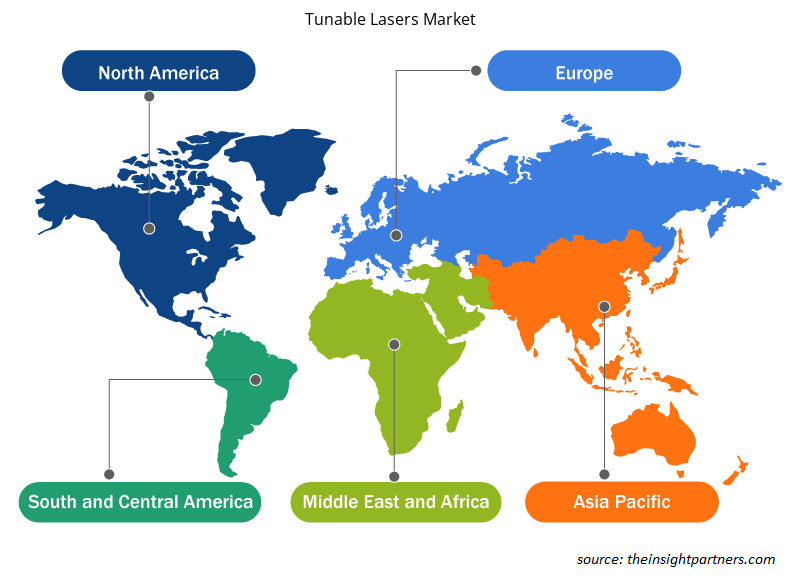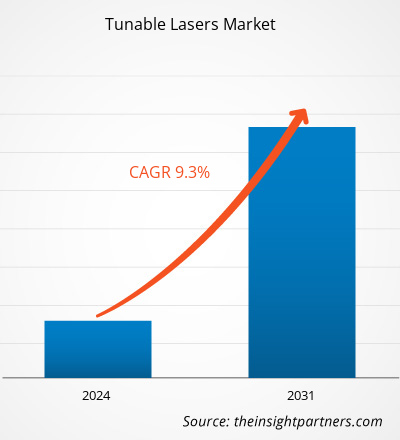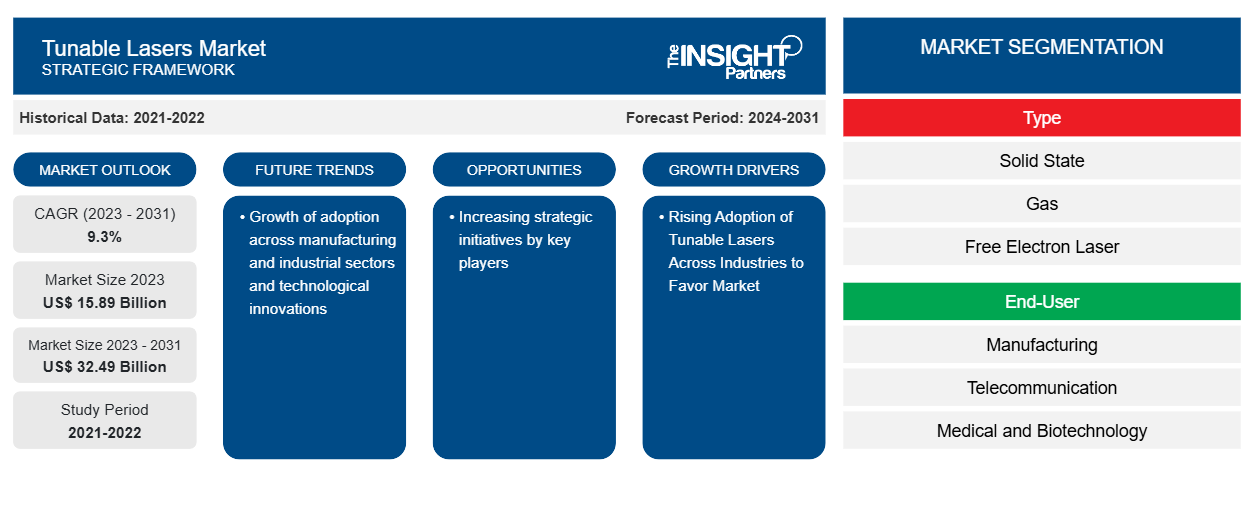La taille du marché des lasers accordables devrait atteindre 32,49 milliards USD d'ici 2031, contre 15,89 milliards USD en 2023. Le marché devrait enregistrer un TCAC de 9,3 % au cours de la période 2023-2031. L'augmentation de la capacité des composants à fibre optique grâce à la reconfigurabilité dynamique devrait rester une tendance clé sur le marché des lasers accordables.tunable lasers market size is projected to reach US$ 32.49 billion by 2031 from US$ 15.89 billion in 2023. The market is expected to register a CAGR of 9.3% during 2023–2031. An increase in the capacity of fiber optic components through dynamic reconfigurability is likely to remain a key trend in the tunable laser market.
Analyse du marché des lasers accordables Lasers Market Analysis
L'augmentation de la capacité des composants à fibre optique grâce à la reconfigurabilité dynamique devrait encore stimuler la croissance du marché des lasers accordables dans les années à venir. En outre, des facteurs tels que les innovations technologiques constantes, la décélération des prix des produits, la consolidation des acteurs et la rivalité féroce propulsent la demande de lasers accordables dans diverses applications, telles que la photochimie, la spectroscopie, les communications optiques et la séparation isotopique par laser à vapeur atomique. Pour développer diverses technologies photoniques, telles que la détection et la télémétrie par lumière (LiDAR), la fibre optique, les lentilles optiques, l'étude des émissions nucléaires et la spectroscopie à diode laser, les instituts de recherche scientifique et les universités du monde entier s'appuient sur des équipements de mesure précis. L'utilisation généralisée de lasers accordables en photobiologie, imagerie hyperspectrale, étalonnage de détecteurs et spectroscopie (réflexion et transmission), associée à l'augmentation de l'utilisation de lasers accordables dans plusieurs applications médicales telles que les applications thérapeutiques, diagnostiques et les traitements de rajeunissement du visage et de la peau au laser, propulse la croissance du marché des lasers accordables.
Aperçu du marché des lasers accordables
Un laser accordable est un laser dont la longueur d'onde de fonctionnement peut être modifiée de manière contrôlée. Bien que tous les supports de gain laser permettent de petits changements dans la longueur d'onde de sortie, seuls certains types de lasers permettent un réglage continu sur une plage de longueurs d'onde considérable. Les lasers accordables permettent d'ajuster la longueur d'onde de sortie en fonction de ses cas d'utilisation. Un réglage à grande vitesse est possible avec certains lasers accordables, appelés agiles en longueur d'onde ou agiles en fréquence. Ces lasers fonctionnent généralement en mode continu avec une bande passante d'émission étroite.
Personnalisez ce rapport en fonction de vos besoins
Vous bénéficierez d'une personnalisation gratuite de n'importe quel rapport, y compris de certaines parties de ce rapport, d'une analyse au niveau des pays, d'un pack de données Excel, ainsi que de superbes offres et réductions pour les start-ups et les universités.
-
Obtenez les principales tendances clés du marché de ce rapport.Cet échantillon GRATUIT comprendra une analyse de données, allant des tendances du marché aux estimations et prévisions.
Moteurs et opportunités du marché des lasers accordables
L'adoption croissante des lasers accordables dans toutes les industries favorise le marché
L'adoption croissante des lasers accordables dans diverses industries stimule sans aucun doute la croissance du marché des lasers accordables. Ces lasers sont fréquemment utilisés dans la fabrication, les télécommunications, la médecine et la biotechnologie, l'aérospatiale, l'électronique et les semi-conducteurs, l'industrie et d'autres. Chacune de ces industries connaît une croissance d'année en année, ce qui entraîne une demande croissante de lasers accordables. De plus, les lasers accordables se concentrent sur l'architecture et la technologie. Ils sont bénéfiques dans l'astronomie, l'aviation, l'énergie, les communications, la défense, l'imagerie, l'interférométrie, la médecine, la microscopie et la spectroscopie . Ainsi, compte tenu des paramètres ci-dessus, la demande croissante de lasers accordables stimule le marché des lasers accordables.tunable lasers across various industries is definitely driving the growth of the tunable laser market. These lasers are frequently used in manufacturing, telecommunication, medical and biotechnology, aerospace, electronics and semiconductor, industrial, and others. Each of these industries is growing year on year, which is resulting in the surging demand for tunable lasers. Further, the tunable lasers focus on architecture and technology. They are beneficial in astronomy, aviation, energy, communications, defense, imaging, interferometry, medicine, microscopy, and tunable lasers is driving the tunable lasers market.
Multiplier les initiatives stratégiques des acteurs clés.
Les principaux acteurs du marché prennent diverses initiatives telles que des lancements de produits, des partenariats et des stratégies organiques et inorganiques pour stimuler la croissance du marché. Par exemple, en décembre 2023, LioniX International a présenté un laser accordable intégré innovant de haute précision qui fonctionne à 1310 nm dans la bande O, visant des applications à forte croissance dans les domaines de la détection optique et des communications optiques. La collaboration entre LioniX, Sivers Photonics et Chilas a donné naissance à ce laser, tout juste sorti du laboratoire et prêt à redéfinir les normes de l'industrie. De plus, de nombreuses autres entreprises prennent l'initiative, ce qui offrira des opportunités potentielles pour le marché.LioniX International introduced an innovative high-precision integrated tunable laser that operates at 1310 nm in the O-band, aiming for high-growth applications across optical sensing and optical communications. The collaboration between LioniX, Sivers Photonics, and Chilas gave rise to this laser, hot off the lab bench and ready to redefine industry standards. Moreover, many other companies are taking the initiative, which will hold some potential opportunities for the market.
Analyse de segmentation du rapport sur le marché des lasers accordables
Les segments clés qui ont contribué à la dérivation de l’analyse du marché des lasers accordables sont le type, la cause, l’utilisateur final, la technologie et la longueur d’onde.
- En fonction du type, le marché des lasers accordables est divisé en lasers à semi-conducteurs, à gaz, à électrons libres (FEL) et autres. Le segment des lasers à semi-conducteurs devrait détenir une part de marché importante au cours de la période de prévision.
- En fonction de l'utilisateur final, le marché est segmenté en secteurs manufacturier, télécommunication, médical et biotechnologie, aérospatiale, électronique, semi-conducteurs, industriel et autres. Le secteur manufacturier devrait détenir une part de marché importante au cours de la période de prévision.
- En termes de technologie, le marché est divisé en laser à diode à cavité (DBR), laser à réflecteur de Bragg distribué (DFB), lasers à cavité verticale émettant par la surface (VCSEL), systèmes microélectromécaniques (MEMS) et autres. Le segment des lasers à diode à cavité (DBR) devrait détenir une part de marché importante au cours de la période de prévision.
Analyse des parts de marché des lasers accordables par géographie
La portée géographique du rapport sur le marché des lasers accordables est principalement divisée en cinq régions : Amérique du Nord, Asie-Pacifique, Europe, Moyen-Orient et Afrique, et Amérique du Sud et centrale.
L’Amérique du Nord a dominé leMarché des lasers accordables. Les tendances d'adoption de haute technologie dans diverses industries de la région nord-américaine ont alimenté la croissance du marché des lasers accordables. Des facteurs tels que l'adoption accrue de la technologie numérique et les dépenses technologiques élevées des agences gouvernementales devraient stimuler la croissance du marché nord-américain des lasers accordables. De plus, l'accent mis sur la recherche et le développement dans les économies développées des États-Unis et du Canada oblige les acteurs nord-américains à introduire sur le marché des solutions technologiquement avancées. En outre, les États-Unis comptent un grand nombre d'acteurs du marché des lasers accordables qui se concentrent de plus en plus sur le développement de solutions innovantes. Tous ces facteurs contribuent à la croissance du marché des lasers accordables dans la région.
Laser accordable
Aperçu régional du marché des lasers accordables
Les tendances régionales et les facteurs influençant le marché des lasers accordables tout au long de la période de prévision ont été expliqués en détail par les analystes d’Insight Partners. Cette section traite également des segments et de la géographie du marché des lasers accordables en Amérique du Nord, en Europe, en Asie-Pacifique, au Moyen-Orient et en Afrique, ainsi qu’en Amérique du Sud et en Amérique centrale.

- Obtenez les données régionales spécifiques au marché des lasers accordables
Portée du rapport sur le marché des lasers accordables
| Attribut de rapport | Détails |
|---|---|
| Taille du marché en 2023 | 15,89 milliards de dollars américains |
| Taille du marché d'ici 2031 | 32,49 milliards de dollars américains |
| Taux de croissance annuel composé mondial (2023-2031) | 9,3% |
| Données historiques | 2021-2022 |
| Période de prévision | 2024-2031 |
| Segments couverts |
Par type
|
| Régions et pays couverts |
Amérique du Nord
|
| Leaders du marché et profils d'entreprises clés |
|
Densité des acteurs du marché des lasers accordables : comprendre son impact sur la dynamique commerciale
Le marché des lasers accordables connaît une croissance rapide, tirée par la demande croissante des utilisateurs finaux en raison de facteurs tels que l'évolution des préférences des consommateurs, les avancées technologiques et une plus grande sensibilisation aux avantages du produit. À mesure que la demande augmente, les entreprises élargissent leurs offres, innovent pour répondre aux besoins des consommateurs et capitalisent sur les tendances émergentes, ce qui alimente davantage la croissance du marché.
La densité des acteurs du marché fait référence à la répartition des entreprises ou des sociétés opérant sur un marché ou un secteur particulier. Elle indique le nombre de concurrents (acteurs du marché) présents sur un marché donné par rapport à sa taille ou à sa valeur marchande totale.
Les principales entreprises opérant sur le marché des lasers accordables sont :
- Cohérence Corp
- Léonardo DRS
- EXFO inc.
- Photonique HÜBNER
- Keysight Technologies
- Luna Innovations Incorporée
Avis de non-responsabilité : les sociétés répertoriées ci-dessus ne sont pas classées dans un ordre particulier.

- Obtenez un aperçu des principaux acteurs du marché des lasers accordables
Actualités et développements récents du marché des lasers accordables
Le marché des lasers accordables est évalué en collectant des données qualitatives et quantitatives après des recherches primaires et secondaires, qui comprennent d'importantes publications d'entreprise, des données d'association et des bases de données. Quelques-uns des développements du marché des lasers accordables sont répertoriés ci-dessous :
- Pilot Photonics a annoncé la disponibilité d'un nouveau module laser largement réglable. Il s'agit du seul laser réglable disponible dans le commerce qui offre la combinaison insaisissable d'une commutation en nanosecondes et d'une largeur de ligne étroite, résolvant ainsi un défi de longue date dans l'industrie.
(Source : site Web de la société Pilot Photonics, janvier 2023)
- Sivers Semiconductors AB (« Sivers ») a annoncé que sa filiale, Sivers Photonics, a entamé un nouveau partenariat avec LioniX International et Chilas BV pour développer et fournir un laser O-Band CW Tunable 1310 nm intégré à largeur de ligne étroite ciblant les applications à forte croissance dans les secteurs des communications optiques et de la détection optique.
(Source : Sivers Semiconductors AB, site Web de l'entreprise, décembre 2023)
Rapport sur le marché des lasers accordables : couverture et livrables
Le rapport « Taille et prévisions du marché des lasers accordables (2021-2031) » fournit une analyse détaillée du marché couvrant les domaines ci-dessous :
- Taille et prévisions du marché des lasers accordables aux niveaux mondial, régional et national pour tous les segments de marché clés couverts dans le cadre.
- Tendances du marché des lasers accordables ainsi que dynamique du marché telles que les moteurs, les contraintes et les opportunités clés.
- Analyse détaillée des cinq forces de PEST/Porter et SWOT.
- Analyse du marché des lasers accordables couvrant les principales tendances du marché, le cadre mondial et régional, les principaux acteurs, les réglementations et les développements récents du marché.
- Analyse du paysage industriel et de la concurrence couvrant la concentration du marché, l'analyse de la carte thermique, les principaux acteurs et les développements récents du marché des lasers accordables.
- Profils d'entreprise détaillés.
- Analyse historique (2 ans), année de base, prévision (7 ans) avec TCAC
- Analyse PEST et SWOT
- Taille du marché Valeur / Volume - Mondial, Régional, Pays
- Industrie et paysage concurrentiel
- Ensemble de données Excel
Rapports récents
Rapports connexes
Témoignages
Raison d'acheter
- Prise de décision éclairée
- Compréhension de la dynamique du marché
- Analyse concurrentielle
- Connaissances clients
- Prévisions de marché
- Atténuation des risques
- Planification stratégique
- Justification des investissements
- Identification des marchés émergents
- Amélioration des stratégies marketing
- Amélioration de l'efficacité opérationnelle
- Alignement sur les tendances réglementaires























 Obtenez un échantillon gratuit pour - Marché des lasers accordables
Obtenez un échantillon gratuit pour - Marché des lasers accordables